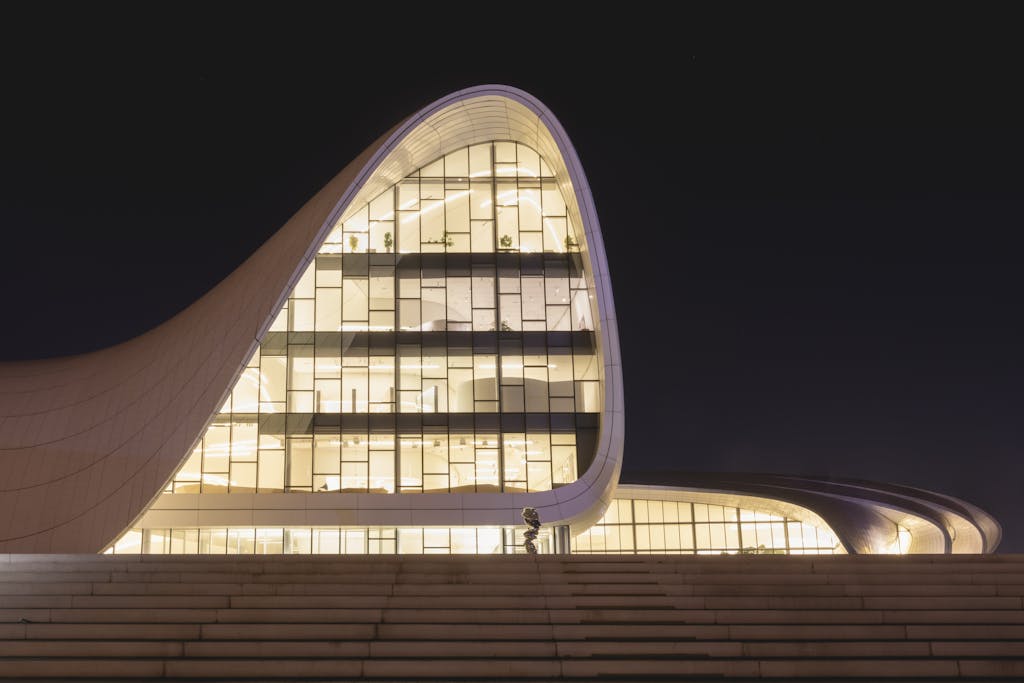Introduction
Sculptural architecture is an artistic approach to building design that places as much importance on form as on function. Where traditional architecture typically emphasizes structure and utility, sculptural architecture challenges this notion by considering the artistic expression of the building itself. This type of architecture turns buildings into works of art, with intricate, often bold, and highly conceptual forms that serve both an aesthetic and functional purpose. In this article, we explore the fusion of art and functionality in sculptural architecture, its evolution, key trends, and iconic examples.
What is Sculptural Architecture?
Sculptural architecture refers to buildings or structures whose form is designed to evoke artistic expression. These buildings don’t just fulfill the traditional role of providing shelter or space; they are intended to engage the viewer visually and emotionally. Sculptural architecture often involves bold geometries, unconventional materials, and cutting-edge design techniques, making the building appear as much a sculpture as a habitable space.
Unlike more utilitarian architectural styles, sculptural architecture blends artistic creativity with functional requirements. For example, while a sculptural building may have complex curves or intricate detailing, it is still designed with the needs of its inhabitants in mind. These buildings challenge the idea that architecture must be solely practical, instead emphasizing how form, texture, and shape can influence human perception and interaction.
The Evolution of Sculptural Architecture
The roots of sculptural architecture can be traced back to early 20th-century modernism, particularly movements like expressionism and deconstructivism. Expressionist architects such as Erich Mendelsohn and Hans Scharoun used organic forms to convey emotional impact, paving the way for more sculptural buildings in the post-war era.
However, the true flourishing of sculptural architecture came in the late 20th and early 21st centuries with architects like Frank Gehry, Zaha Hadid, and Santiago Calatrava. Their work embraced technology, advanced materials, and cutting-edge design software, allowing them to create buildings that were both functional and visually arresting.
Key characteristics of sculptural architecture include:
- Curves and Organic Shapes: Many sculptural buildings feature sweeping curves and fluid, organic forms that contrast with the rigid, geometric lines of traditional architecture.
- Dynamic Structures: Sculptural architecture often seeks to convey a sense of movement, with designs that appear to be in constant flux.
- Innovative Materials: The use of advanced materials like titanium, glass, and carbon fiber allows architects to push the limits of form and structure.
- Spatial Complexity: Sculptural buildings often have complex, irregular floor plans, creating dynamic interior spaces that challenge conventional notions of layout.

Iconic Examples of Sculptural Architecture
Several landmark buildings around the world are prime examples of sculptural architecture, showcasing the successful fusion of art and function.
- The Guggenheim Museum Bilbao, Spain (Frank Gehry): Perhaps the most famous example of sculptural architecture, the Guggenheim Museum Bilbao is known for its bold, flowing curves and titanium-clad exterior. The building’s form is meant to evoke a sense of movement, drawing inspiration from the natural environment.
- The London Aquatics Centre, UK (Zaha Hadid): This stunning building, designed for the 2012 London Olympics, features sweeping curves and a roof that resembles the fluid form of a wave. The use of organic forms creates an aesthetic that evokes both the movement of water and the performance of athletes.
- The Turning Torso, Sweden (Santiago Calatrava): This skyscraper is a prime example of sculptural architecture that also addresses functionality. The twisting, curving shape of the tower reflects both its artistic vision and the structural integrity required for a high-rise building.
- The Walt Disney Concert Hall, Los Angeles (Frank Gehry): With its bold, deconstructivist curves and stainless steel panels, the Walt Disney Concert Hall is a visual masterpiece. The fluid shapes create a sense of harmony with the surrounding city while also providing an acoustically optimized venue for music.
Challenges of Sculptural Architecture
While sculptural architecture represents an exciting evolution of design, it does come with certain challenges:
- Cost and Complexity: Sculptural buildings often require advanced materials and construction techniques, leading to higher costs and longer construction times.
- Structural Integrity: The complex forms that make sculptural buildings visually arresting can sometimes be difficult to engineer, requiring innovative solutions to ensure safety and durability.
- Public Reception: Not everyone appreciates the aesthetic of sculptural architecture, and some designs may face criticism for being too avant-garde or impractical.
The Future of Sculptural Architecture
As technology continues to advance, the possibilities for sculptural architecture are boundless. Computational design tools, 3D printing, and robotic fabrication are allowing architects to experiment with new forms and materials. The future of sculptural architecture lies in the continued exploration of how art and function can coexist, creating buildings that are not only practical but also transformative.